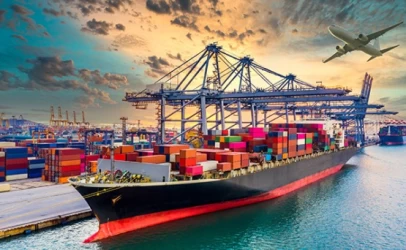Guide to trade with Vietnam, sea freight
Vietnam has emerged as one of Southeast Asia's most dynamic economies, making it an attractive trade partner for global businesses. Whether you're considering exporting or importing goods to or from Vietnam, understanding the country's trade regulations, shipping infrastructure, and logistical considerations is crucial. This guide offers an in-depth overview of the key aspects of trading with Vietnam, with a particular focus on maritime transportation.
1. Overview of Vietnam's Economy
Vietnam's economy has experienced significant growth over the past few decades. Key export industries include electronics, textiles, footwear, agricultural products, and machinery. The country is also a member of several trade agreements, such as the Comprehensive and Progressive Agreement for Trans-Pacific Partnership (CPTPP) and the Regional Comprehensive Economic Partnership (RCEP), which provide preferential access to a wide range of markets.
2. Key Trade Agreements
Vietnam has embraced free trade and signed numerous bilateral and multilateral agreements, making it an essential trade hub in Southeast Asia. These agreements have reduced tariffs and trade barriers, facilitating easier access for businesses seeking to engage in trade with Vietnam. Some notable trade agreements include:
- ASEAN Free Trade Area (AFTA): Promotes trade among Southeast Asian countries.
- European Union-Vietnam Free Trade Agreement (EVFTA): This agreement provides duty-free access for many products between Vietnam and the EU.
- Vietnam-Korea Free Trade Agreement (VKFTA): Strengthens trade between Vietnam and South Korea.
Understanding these agreements is essential for navigating tariffs, trade barriers, and regulations when importing or exporting to Vietnam.
3. Maritime Transportation Infrastructure
Maritime transportation is the most critical mode of transportation for international trade in Vietnam. The country has over 3,200 km of coastline and numerous ports, with major maritime routes connecting Vietnam to global markets. Here’s a breakdown of key aspects of the maritime shipping industry:
Major Ports in Vietnam:
- Port of Hai Phong: Located in northern Vietnam, this port is the country’s primary gateway for cargo moving between the north and international markets.
- Port of Ho Chi Minh City (Saigon): One of the busiest ports in southern Vietnam, this port handles a significant portion of the country’s import-export activities.
- Port of Da Nang: This port serves as the gateway for central Vietnam and plays a critical role in trade activities.
- Cai Mep-Thi Vai Port: One of the most modern deep-water ports in the country, serving as an international hub for container ships.
Vietnam’s Maritime Shipping Growth:
Vietnam has seen rapid expansion in its maritime shipping capabilities, supported by its strategic location and growing trade relationships. The nation’s ports have been modernized and expanded, allowing for the handling of larger vessels and an increasing volume of containers.
Shipping Lines:
Several major global shipping companies operate in Vietnam, ensuring frequent and reliable service. Popular shipping lines include Maersk, CMA CGM, and Evergreen. Vietnam's geographical position also makes it a major stop on the maritime routes of the Southeast Asia region.
4. Customs Regulations and Documentation
Trade with Vietnam requires familiarity with its customs regulations. The process of importing and exporting involves a number of documents and procedures. Here’s what you need to know:
- Bill of Lading: Issued by the shipping company to acknowledge the receipt of goods for shipment.
- Commercial Invoice: Contains detailed information about the goods being imported or exported, including their value and description.
- Packing List: Provides a breakdown of the contents of each package being shipped.
- Certificate of Origin: Confirms the origin of the goods, which may be required to benefit from preferential tariffs under free trade agreements.
- Import License: Certain goods may require an import license before they can be legally brought into Vietnam.
Vietnam Customs also employs the VNACCS (Vietnam Automated Cargo and Port Consolidated System), an electronic customs clearance system that facilitates faster processing of goods.
5. Tariffs and Duties
Vietnam's import tariffs vary depending on the goods being imported, the country of origin, and whether a trade agreement is in place. The Vietnamese government imposes:
- Most Favored Nation (MFN) Tariffs: Applied to imports from WTO members.
- Preferential Tariffs: Available for goods originating from countries with which Vietnam has signed trade agreements.
- Non-tariff Barriers: Importers may also face non-tariff barriers, such as quotas, bans, and product certification requirements.
Understanding these tariffs and regulatory frameworks is critical when calculating the total cost of importing goods into Vietnam.
6. Logistics and Supply Chain Considerations
When trading with Vietnam, it’s essential to understand the logistics and supply chain landscape. Factors such as transportation costs, warehousing, and distribution channels can significantly impact the cost and efficiency of moving goods in and out of the country.
- Freight Forwarders: Using a reliable freight forwarder can streamline the import-export process, ensuring your goods reach their destination efficiently and on time.
- Insurance: Maritime insurance is essential for protecting your goods during transit. Insurance policies typically cover damages caused by unforeseen events such as rough seas, piracy, or accidents.
- Warehousing: Vietnam offers a growing number of warehousing and distribution facilities, especially in major cities and industrial zones like Ho Chi Minh City and Hanoi.
7. Challenges and Opportunities in Trading with Vietnam
Vietnam offers many opportunities for businesses but also presents some challenges:
Opportunities:
- Growing Market: Vietnam's fast-growing economy and young population make it an attractive market for many industries.
- Cost-Effective Manufacturing: Vietnam's relatively low labor costs and expanding infrastructure make it a competitive manufacturing hub.
Challenges:
- Complex Regulatory Environment: Navigating Vietnam's legal and regulatory environment can be challenging, particularly for first-time traders.
- Infrastructure Gaps: While improving, Vietnam's transportation and logistics infrastructure, especially outside major cities, may present bottlenecks for trade.
8. Conclusion
Vietnam offers significant opportunities for international trade, with maritime transportation playing a crucial role in connecting the country to global markets. By understanding Vietnam’s ports, shipping routes, trade agreements, and customs regulations, businesses can navigate the complexities of trading with this dynamic country. Leveraging Vietnam’s growing economy and trade relationships can lead to fruitful partnerships and successful import-export operations.
If you have any specific questions or need further assistance, feel free to ask!











